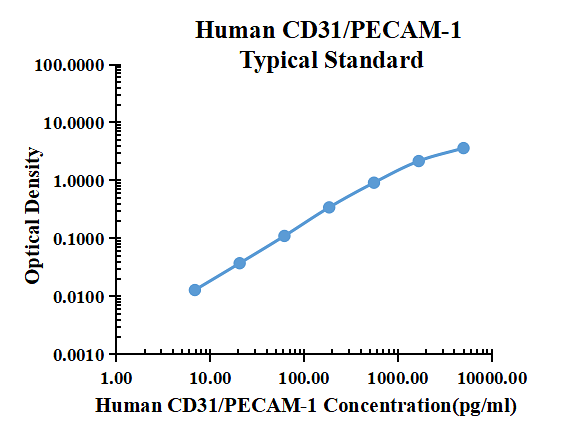Human CD31/PECAM-1 enzyme-linked immunoassay kit
| Specification | 96 Test |
|---|---|
| Sensitivity | 0.06 pg/ml (50 μl);1.94 pg/ml (10 μl); |
| Standard Curve Range | 6.86~5000 pg/ml |
| Standard Curve Gradient | 7 Points/3 Folds |
| Number of Incubations | 2 |
| Detectable sample | Liquid phase sample of soluble substances. For example: serum, plasma, cell culture supernatant, tissue grinding liquid, etc. |
| Sample Volume | 50 μl/10 μl |
| Type | Fully Ready-to-Use |
| Operation Duration | 120min |

| pg/ml | O.D. | Average | Corrected | |
|---|---|---|---|---|
| 0.00 | 0.0081 | 0.0084 | 0.0083 | |
| 6.86 | 0.0211 | 0.0212 | 0.0212 | 0.0129 |
| 20.58 | 0.0481 | 0.0432 | 0.0457 | 0.0374 |
| 61.73 | 0.1258 | 0.1117 | 0.1188 | 0.1105 |
| 185.19 | 0.3603 | 0.3432 | 0.3518 | 0.3435 |
| 555.56 | 0.9777 | 0.8702 | 0.9240 | 0.9157 |
| 1666.67 | 2.2370 | 2.1020 | 2.1695 | 2.1613 |
| 5000.00 | 3.6500 | 3.6030 | 3.6265 | 3.6183 |
Precision
| Intra-assay Precision | Inter-assay Precision | |||||
| Sample Number | S1 | S2 | S3 | S1 | S2 | S3 |
| 22 | 22 | 22 | 6 | 6 | 6 | |
| Average(pg/ml) | 31.8 | 155.8 | 497.5 | 26.7 | 140.6 | 449.5 |
| Standard Deviation | 2.0 | 10.6 | 32.4 | 1.9 | 10.0 | 28.1 |
| Coefficient of Variation(%) | 6.4 | 6.8 | 6.5 | 7 | 7.1 | 6.2 |
Intra-assay Precision (Precision within an assay) Three samples of known concentration were tested twenty times on one plate to assess intra-assay precision.
Inter-assay Precision (Precision between assays) Three samples of known concentration were tested six times on one plate to assess intra-assay precision.
Spike Recovery
The spike recovery was evaluated by spiking 3 levels of human CD31/PECAM-1 into health human serum sample. The un-spiked serum was used as blank in this experiment.
The recovery ranged from 80% to 118% with an overall mean recovery of 98%.
Sample Values
| Sample Matrix | Sample Evaluated | Range (ng/ml) | Detectable (%) | Mean of Detectable (ng/ml) |
|---|---|---|---|---|
| Serum | 30 | 13.76-23.75 | 100 | 16.93 |
Serum/Plasma – Thirty samples from apparently healthy volunteers were evaluated for the presence of CD31/PECAM-1 in this assay. No medical histories were available for the donors.
Product Data Sheet
Background: CD31/PECAM-1
PECAM-1 (Platelet-Endothelial Cell Adhesion Molecule-1), also known as CD31, is a 130 kDa type I transmembrane glycoprotein adhesion molecule in the immunoglobulin superfamily. Expression is restricted to cells involved in circulation, especially endothelial cells, platelets, monocytes, neutrophils and lymphocyte subsets. PECAM-1 is concentrated at cell-cell junctions and is required for Transendothelial Migration (TEM). The Extracellular Domain (ECD) of PECAM-1 has ten potential N-linked glycosylation sites and six C2-type Ig-like domains, the first of which is critical for adhesion and extravasation. The cytoplasmic domain contains Immunoregulatory Tyrosine-based Inhibitory and Switch Motifs (ITIM, ITSM) that mediate both inhibition and activation via phosphotyrosine-mediated engagement of SH2-containing signaling molecules. Metalloproteinase-mediated ectodomain shedding occurs during apoptosis but increased serum PECAM-1 ectodomain in HIV and active multiple sclerosis occurs independent of apoptosis. In humans, expression of six isoforms with exon deletions in the cytoplasmic domain is tissue- and stage-specific, but full-length PECAM-1 is predominant. A form lacking the ITSM predominates in mouse. Mouse PECAM-1 ECD shows 77%, 63%, 63%, 63%, and 61% amino acid (aa) identity with rat, human, canine, porcine, and bovine PECAM-1, respectively. PECAM-1 participates with other adhesion molecules in some functions, but is the critical molecule for TEM. Homotypic PECAM-1 adhesion in trans, combined with cycling of PECAM-1 to and from surface-connected endothelial cell vesicles, leads leukocytes across endothelial tight junctions. Homotypic adhesion and signaling functions also strongly suppress mitochondria-dependent apoptosis. In platelets, PECAM-1 is necessary for limiting thrombus formation and promoting integrin-mediated clot retraction and platelet spreading, but mechanisms for these phenomena are unclear. PECAM-/- mice are deficient in chemokine-mediated chemotaxis .

